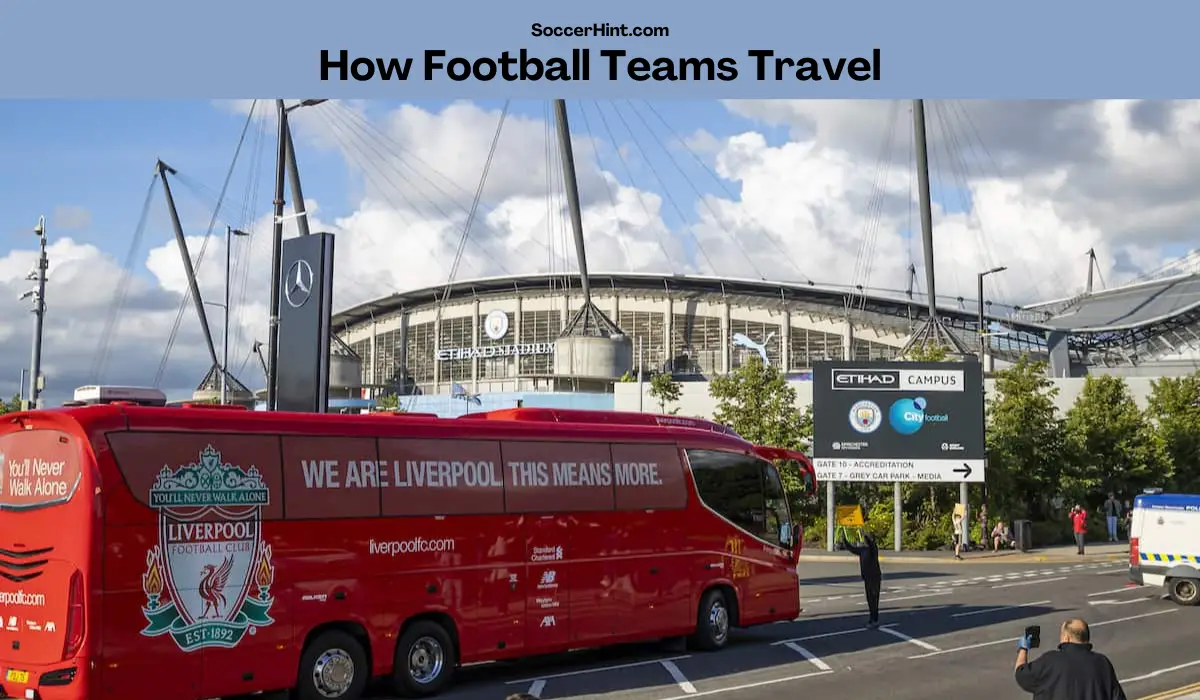As the adrenaline-pumping moments of the football match unfold on the field, there’s an often overlooked aspect that contributes significantly to the overall spectacle—the journey of the teams to away games. Have you ever wondered how your favourite football team covers the miles to reach the battlegrounds of rival territories? Let’s dive into the fascinating world of how football teams travel to away games.
In competitive football, the journey begins long before the first whistle blows, as teams embark on a literal and metaphorical road trip to face their opponents.
The method of travel isn’t just a logistical detail; it’s a crucial part of the team’s preparation and camaraderie. So, how exactly do these sporting gladiators navigate to reach their away destinations?
Read Also: How Football Teams Get Their Names
3 Major Ways Football Teams Travel To Away Games
The journey to away games is a crucial yet often overlooked aspect of the beautiful game. Whether it’s a local derby or a continental clash, the means of transportation adopted by football teams play a pivotal role in shaping the team’s mindset and preparedness for battle. Let’s explore the various avenues through which top-level football teams traverse the miles to reach the arenas of their rivals.
1. Team Buses
For shorter distances, the trusty team bus emerges as the go-to mode of transport. Picture this: a convoy of athletes, coaches, and support staff cruising down the highways, the anticipation of the upcoming match permeating the air. This is not merely a commute; it’s an essential chapter in team bonding and strategy sessions. Teams like Manchester United and Barcelona are known for their iconic bus journeys, turning each ride into a prelude to victory.
2. Air Travel
When the away fixture is situated far from home, football teams take to the skies. Chartered flights become the wings that carry them swiftly to their destination. The luxury of air travel not only minimizes the time spent in transit but also allows players to rest and recuperate before the showdown. Premier League giants like Liverpool and Real Madrid are no strangers to the skies, ensuring their stars arrive fresh and ready to conquer.
3. Train Journeys
In the realm of European football, especially during continental competitions like the UEFA Champions League, teams might opt for train travel. This offers a blend of efficiency and camaraderie as players traverse picturesque landscapes. Teams like Bayern Munich and Paris Saint-Germain have embraced train journeys as a unique way to prepare for crucial matches, forging a sense of unity amidst the rhythmic clatter of the tracks.
Read Also: Why The UEFA Champions League is Popular
Factors To Consider
Behind the scenes, meticulous planning unfolds to ensure seamless journeys. Factors such as distance, scheduling, and even time zone differences are considered. This strategic approach ensures that teams have sufficient time to acclimate, recover, and fine-tune their game plans. The logistics of travel are as crucial as the tactics on the field.
For top-tier clubs participating in prestigious continental competitions like the UEFA Champions League, the travel dynamics amplify. Transcontinental flights, time zone adjustments, and adapting to diverse climates become part of the challenge.
Read Also: How Many Champions League Games Are Played Per Season?
Who Bears The Transportation Cost And How Is It Done?
The logistical intricacies of football travel are not only about securing the mode of transportation but also about answering the fundamental question of who shoulders the financial burden. Let’s peel back the curtain and explore the dynamics of funding football team travel, from the club’s responsibility to the offices that manage the approval and logistics.
In the vast majority of cases, it is the football club that bears the brunt of transportation costs for away games. This includes expenses related to flights, buses, accommodation, and other logistical elements. The club’s financial health and budget allocation play pivotal roles in determining the quality and comfort of the team’s journey.
Within a football club, decisions related to travel expenses are typically managed by the higher echelons of club management. The responsibility may fall under the purview of the club’s administrative and financial departments, overseen by top executives or the board of directors. The day-to-day handling of these matters might be delegated to specific offices within the club structure.
The responsibility for overseeing the logistical aspects of football travel often falls under the domain of the sporting director’s office or a similar football operations department. This office is tasked with coordinating various elements related to the team’s activities, including travel arrangements. They work closely with travel agencies, accommodation providers, and transportation services to ensure a smooth journey for the team.
Before any travel plans are set in motion, budget approval is a crucial step. The club’s financial team, in collaboration with the board or relevant decision-makers, reviews and approves the budget earmarked for away game travel. This process ensures that there is a clear financial plan in place, aligning with the overall budgetary constraints and priorities of the club.
While players are the central figures in the football narrative, their involvement in the financial aspects of travel is typically limited. The responsibility for handling costs, logistics, and approvals falls squarely on the club’s administrative and management teams. Players are free to concentrate on their training and performance without delving into the financial minutiae of travel arrangements.
However, It’s important to note that variations exist among football clubs. Some might have a more centralized approach to decision-making, while others may distribute responsibilities across multiple offices. Club-specific practices and structures can influence how travel expenses are managed and who holds the authority for approval
Read Also: How Players Learn New Languages
Conclusion
As we’ve explored the diverse avenues of how football teams travel to away games, it becomes evident that this journey is not just a physical transit; it’s a testament to the meticulous planning, financial acumen, and collaborative efforts that underpin the beautiful game.
From the hum of team buses to the soaring heights of chartered flights, the modes of transportation are not just a means of conveyance but vessels carrying the hopes and aspirations of fans worldwide. The responsibility for this odyssey rests on the shoulders of football clubs, whose administrative and sporting director offices navigate the logistics with finesse, ensuring that the players can focus solely on the game.
The financial intricacies, budget approvals, and strategic decisions form the backbone of these travels, showcasing the business acuity intertwined with the sporting spectacle. It’s a collective endeavour where club finances, broadcasting rights, sponsorships, and league support harmonize to create a seamless experience for players and fans alike.
So, as the team buses roll out and planes take flight, it’s a salute to the unseen heroes—the decision-makers, coordinators, and financial architects—that make the away game journey a reality.
In the end, whether on the road, in the air, or on the tracks, the journey to away games encapsulates the essence of the footballing spirit—a relentless pursuit of victory, camaraderie, and the unwavering commitment to the beautiful game that transcends borders and unites fans across the globe. As we celebrate the goals, saves, and victories, let’s also raise a cheer for the journey “On the Road Again,” where every mile tells a story of dedication and resilience in the world’s most beloved sport.





